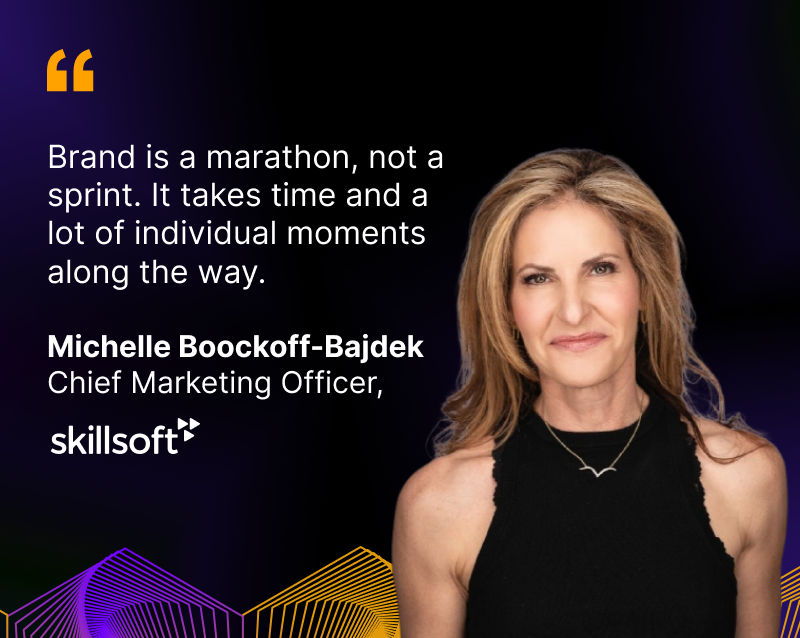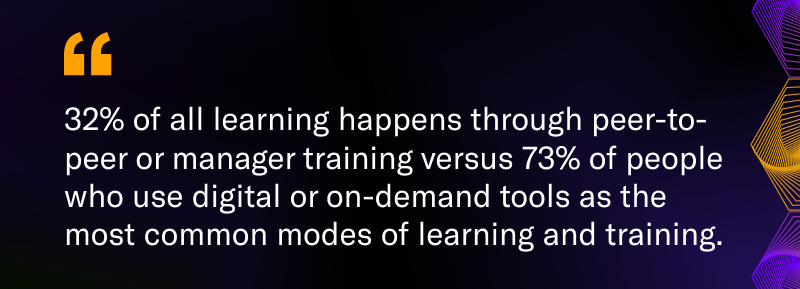Reshaping the Future of Learning and Development: Meet Michelle Boockoff-Bajdek from Skillsoft

Maximize Your Marketing ROI
Join 10,000 other marketers already getting the best tips on running engaging events that boost pipeline and create raving fans.
In this episode of CMO Diaries, Kishore sat down with Michelle Boockoff-Bajdek, Chief Marketing Officer at Skillsoft.
Skillsoft is a cloud-based learning management software that provides businesses with scenario-based courses, videos, online books, and other resources to train employees. In Michelle’s own words, “Our belief is that every person has the potential to be amazing. Our purpose is to help people unleash that potential through learning. And our vision is to prepare the workforce of today with the skills for tomorrow.”
Michelle shared insight from her time marketing IBM’s Watson product, her perspective on how marketing teams should think about public relations, and how Skillsoft’s podcast, The Edge, came to life as a creative way to promote their annual customer event.

How did you set up a Marketing team for Watson, a product that has so many different personas and use cases?
It came down to figuring out which are the most valuable and specific use cases? And then we built what we call “Diamond Teams” or “Agile Squads.”
We operated entirely agile. Each squad was responsible for a particular AI solution and a specific use case. They were responsible for identifying the personas for those specific use cases. And, they were responsible for creating the customer journeys from acquisition all the way through to retention, growth, and advocacy. Those squads were really laser-focused on their audience, they knew the systems, and they knew what people needed.
One of the other things that became really important was to not just focus on acquisition campaigns or the customer journeys, but also reshaping the way in which people viewed Watson. So for us, that came through brand and thought leadership initiatives.
How did you approach building Watson’s brand at IBM?
Watson, as a brand, is iconic. So, it was really important that when I took over the reins as the CMO, we retained all that was good in that brand to continue to propel it forward. Watson already had a tremendous amount of affinity, visibility, and really positive perception. As the shepherd and steward of the brand, it was my job to continue to move it forward.
But let's be clear—that was a brand that existed, and I think there was a tremendous halo that we were able to leverage as a result. Which was great!
But building a brand when you are not an IBM and when you don't have a Watson, it becomes a lot more challenging. Brand is a marathon, not a sprint. It takes time and a lot of individual moments along the way.

It's interesting because when I started to work on the brand here at Skillsoft, one of the things that I really came to realize is that every single moment and every single touch point is another opportunity to either build the brand up or take the brand down.
My favorite expression is “marketing is too important to be left to the marketing department.” And I say that with respect to brand because every single individual in an organization has the opportunity to contribute to the brand because brand is how you experience a company.
I like to remind people that we all have an obligation to support the experiences that we deliver for our customers on behalf of the company, regardless of what role you're in.
When should companies think about leveraging PR?
I think how you prioritize and structure PR and communications depends on what stage your company is at. But I do think that, no matter the size or stage, PR can and should be a piece of the overall marketing puzzle.
I think the nature of PR will evolve as a company matures because we know that a startup or early stage company is going to have very different goals and opportunities than a mid-stage company or a market leader.
But what's really fascinating to me is less about PR and more about communications, digital, and content marketing and the lines now becoming really blurred. They truly are integrated.
At Skillsoft, my Content and Communications teams work hand-in-hand because there's this idea of building thought leadership and going and getting earned media, but all of it has to work in concert with each other.
When it comes to deciding whether to keep PR in-house or outsource, I don't think that Marketers or Communications Professionals should adopt an “either or” approach.
“When it comes to deciding whether to keep PR in-house or outsource, I don't think that Marketers or Communications Professionals should adopt an ‘either or’ approach.”
At Skillsoft, we've got our corporate communications and content expertise in-house. But we also utilize external resources, both on the content and the communications side. And what's nice about that is that each team brings different perspectives to the table.
My internal folks know our organization, they know our solutions, they know our customers, and they know our goals. Nobody cares more about your business than you do.
But our strategic partners bring new ideas because they have access to what's happening in the market. They are probably working with far more companies that might be experiencing similar or slightly different challenges than we are. So, we get to benefit from their expertise.
Regardless of how you operate, whether internal or external, I think we can all agree that the shared focus of these organizations is the customer. The customer has to come first. And if we are out there talking about our customers and telling their stories, we're going to be successful regardless of where the resources come from.
When was Skillsoft’s podcast, “The Edge,” launched? And what was the goal for that podcast series?
You know, everybody tried something a little bit different during the pandemic. Some people baked bread. Some people bird watched. Early on, we were all a little stir crazy, and everybody was gaining these new skills or looking for things that would give them meaning and purpose. And for me, that was the podcast.
We started The Edge early on in the pandemic, and it ended up being just an amazing outlet for me and a really helpful initiative for the organization.
I'd only been with Skillsoft for about six months when the COVID-19 pandemic became a reality for all of us. All of a sudden, we were staying at home and adjusting to remote work.
Live events became an incredible challenge. We were about to put on Perspectives, our annual customer event. It would have been my very first in-person event with Skillsoft with thousands of people. And I remember on March 2nd, I sat in a room and I started to get this feeling of dread. I didn't know if people were going to come. I was hearing about people's reticence to travel and that this virus might be worse than we imagined. And so on that date, we had to make a very critical decision to take an in-person event and move it digitally. And it turned out to be a wonderful decision.
“During the pandemic, we had to make a very critical decision to take Perspectives, an in-person event, and move it online. And it turned out to be a wonderful decision.”
For our first digital event, we hosted a 24-hour conversation about everything from personal development and DEI training to leading in challenging times and discussions on who owns the skilling agenda. And when we transformed Perspectives into a digital experience, we were able to live this idea that we have—that learning should be accessible and available to everyone. We amassed 42,000 registrants and around 15,000 attendees, which, for an organization like us, was huge.
But even as we scrambled to re-imagine Perspectives, we needed new ways to promote it. We needed ways to engage with a truly digital audience both before but also after the event. So, we started The Edge, and it took on a life of its own. Our first podcast focused on DEI, an issue that's always been important to me.
If you think about the time right around June of 2020, it was challenging so many organizations. We were seeing worldwide social unrest. We were seeing calls for racial equity and justice. And so many of our customers, Chief Human Resources Officers, were struggling to manage a suddenly remote workforce who were asking lots of questions about how they could have those difficult conversations about race within their organizations.
And so, The Edge was born. We've covered so many different topics, from managing a remote workforce, to how companies have accelerated digital transformation in the age of COVID, to one of the topics that's near and dear to my heart, The “Pink Pandemic,” which is the disproportionate impact that COVID-19 has had on women.
When I think about what our customers want and what they need—they're craving information, insight, and intelligence. So, we survey them. We ask, “What's going to be of most interest to you?”
“Everything we do at Skillsoft is seen through the lens of our customers.”
Everything that we do, whether it's the podcast or smaller marketing moments, all of these things are geared to respond to needs in the market that our customers have or trends that we're hearing that are critical to their success. And we find that in doing so, we're creating a community of people who want to come together, who want to have discussions about these topics, and who want to understand what others are doing in order to address similar challenges.
Everything we do at Skillsoft is seen through the lens of our customers.
What are the best ways for employees to pick up new skills?
I don’t discount the value of learning on the job, but my preference is to say that we learn “in the flow of work.” As we're working, yes, we might gain insight from a colleague or a peer, but we also have the tools we need to learn ready.
Let’s say that I'm in an application and I can't figure out how to do something. What if I can actively go in and grab a resource in that moment that I need it. So to me, learning on the job has evolved from, “I'm going to go do it, and I'm going to gain all the skills I need while I'm doing it” to “I'm going to learn in the flow of work so that not only do I learn on the job, but I also have access to all the resources I need.”

If you think about it and look at every marketer's job, every company is a tech company and every department is a technology department. We are hiring data scientists and analysts and digital marketers—nothing is moving faster than technology. I think that learning new skills is absolutely critical.
Learning has evolved, and the most common mode of learning and training is now web-based and on-demand. Our world has shifted so quickly, and informal peer-to-peer or manager training is now third when it used to be first. 32% of all learning now happens in that kind of environment versus 73% of people who are now using digital or on-demand as common modes for learning and training.
Do you have any book recommendations?
Yes! It's a book called The Grit Factor: Courage, Resilience, and Leadership in the most male dominated organization in the world. This story is unbelievable. I recommend this one to everyone.
The second book that I would recommend is The Long Game: How to be a Long-Term Thinker in a Short-Term World. If you think about it, right now, we're all in this very short-term world. So how do you even think about two years from now, five years from now, etc? It's a really great read.
—
That’s all for this week. Thanks so much for joining us, Michelle! We’ll see you all for our next episode of CMO Diaries!

Stay In Touch
Platform
Resources
Company
Community
© 2025 Copyright Goldcast, Inc. All rights reserved.



 Upcoming Events
Upcoming Events Event Series
Event Series On-Demand Events
On-Demand Events

